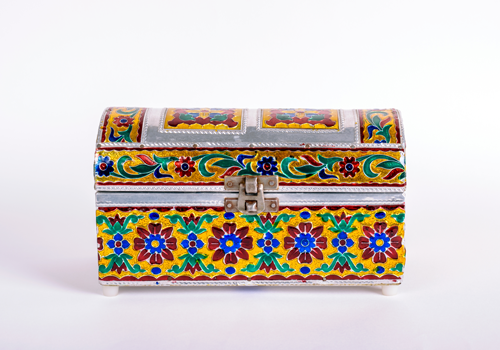
Origin
'Mina' is the feminine form of 'Minoo' in Persian, which means heaven. It refers to the Azure colour of heaven. The Iranian craftsmen of Sassanid era invented this art and Mongols spread it to India and other countries around the world.
Gold was used traditionally for Meenakari jewellery as it held the enamel well and lasted longer. Silver was introduced later and was used for artefacts such as art pieces, spoons, boxes and bowls. Copper was introduced after the Gold Control Act as the Meenakars were forced to look for an alternative for gold.
Process
The traditional process starts with the designer and moves on to the goldsmith, the engraver who engraves the design, the enamelist who applies the colour, the polisher, the stone-setter and the stringer. They all play an important role in creating a beautiful Meenakari design. However, often a single artisan with years of experience performs all these tasks.
The Meenakars engrave the metal surface with intricate designs with the help of a metal stylus, which is then filled in with different colours. It is then placed in a furnace where the colours fuse and harden to become one with the surface. The piece is rubbed with a file gently and cleaned with a mixture of tamarind and lemon to highlight the lustre of each colour. The colours are applied as per their level of hardness, beginning with the hardest. Prior to the application of enamel, the surface of the ornament is cleansed with care. In their raw form, these mixtures do not always show their true colours. They emerge only when they are fired in the kiln. The enamel colours are sourced from Amritsar in Punjab, or from France or Germany.
It is interesting to note that Enameling was practiced in many centres in India and each region specialized in its own variation of style and technique. In Banaras, the speciality of the Meenakars was dusky rose-pink or 'gulabi meena'. In Lucknow, the specialty of the Meenakars was blue and green enameling on silver. This wonderful craft was also practiced in Kashmir, Kangra and Bhawalpur. If you are interested in seeing the process of creation, you can visit two centres present in Jaipur and Delhi!